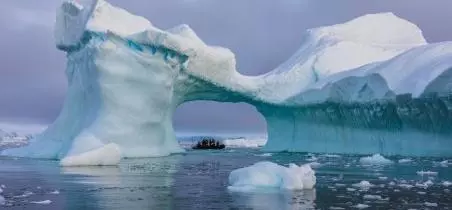
Researchers explain melting of 9,000-year-old Antarctic ice mass
text_fieldsScientists have discovered evidence that the East Antarctic ice sheet in Queen Maud Land quickly melted between 9,000 and 5,000 years ago, during the mid-Holocene, a time when the world experienced summers that were warmer than they are today.
They claimed that after the end of the last ice age, when huge ice sheets had previously covered North America, northern Europe, and southern South America, this area of the East Antarctic ice sheet became thinner. These ice sheets melted, raising the water level by more than 100 metres.
For context, if absolutely all of Antarctica's present-day ice melted, the seas would rise by 58 metres on average. Sixty per cent of the world's freshwater is bound up in Antarctic ice sheets.
"The ice sheet in East Antarctica stores enormous amounts of water. This means that this is the biggest possible source of future sea level rise - up to 53 metres if all of the East Antarctic ice melts - and is seen as the largest source of uncertainties in the future sea level adaptation planning," said Irina Rogozhina, associate professor at the Department of Geography at the Norwegian University of Science and Technology (NTNU), Norway.
While not entirely unexpected, Rogozhina said, they were concerned about the rapid changes the sluggish East Antarctic ice sheet underwent and wanted to find an explanation for it.
However, the harsh, inhospitable conditions of the Antarctic presented challenges towards achieving this.
The researchers were able to find a way to unravel the rapid melting mystery by studying the rocks from nunataks in Queen Maud Land for exposure to cosmic radiation.
"Nunataks are mountains that stick up through the ice," said Ola Fredin, professor at NTNU's Department of Geosciences and Petroleum.
The Antarctic ice sheet is spread across diverse environments. While large parts of the ice sheet lie under sea level, making them vulnerable to ocean warming, much of it in the east sits on land above sea level, meaning it is less sensitive to the ocean's influence.
By studying the rocks' cosmic exposure, they were able to determine the duration for which the rocks remained protected under ice, thus, not absorbing any cosmic radiation.
Further, the researchers believe that they are on track to finding a reason why the ice sheet thinned so much immediately after the end of the last ice age.
"The process is similar to when a house on a hill slope loses its supporting foundation and starts sliding downhill," said Rogozhina.
She said that the less stable, rapidly flowing parts of the ice sheet in East Antarctica, called ice shelves which float on the ocean, were broken up easily because of rising sea levels and warmer water rising from the ocean depths. The water penetrated under the ice margins, melting them from below.
This, in turn, led to the ice sheet becoming much thinner within a relatively short time, geologically speaking, or a few hundreds to thousands of years, she said.
The study describing their findings is published in the Nature Journal Communications Earth & Environment.
With PTI inputs





